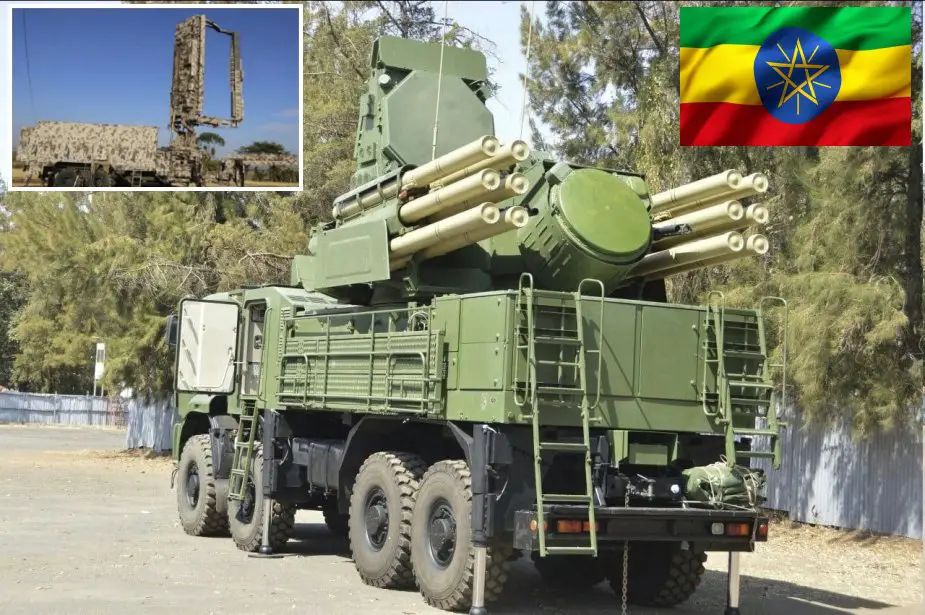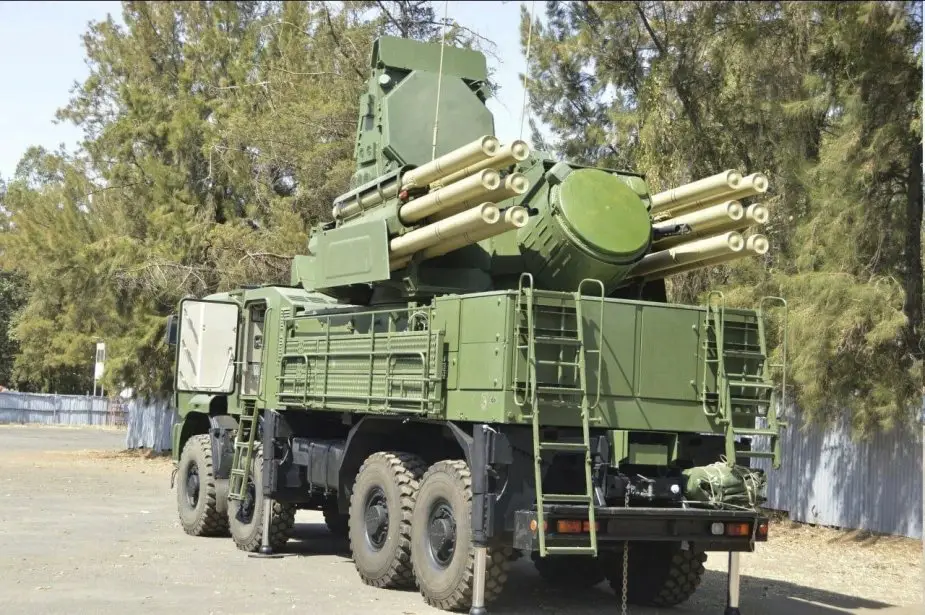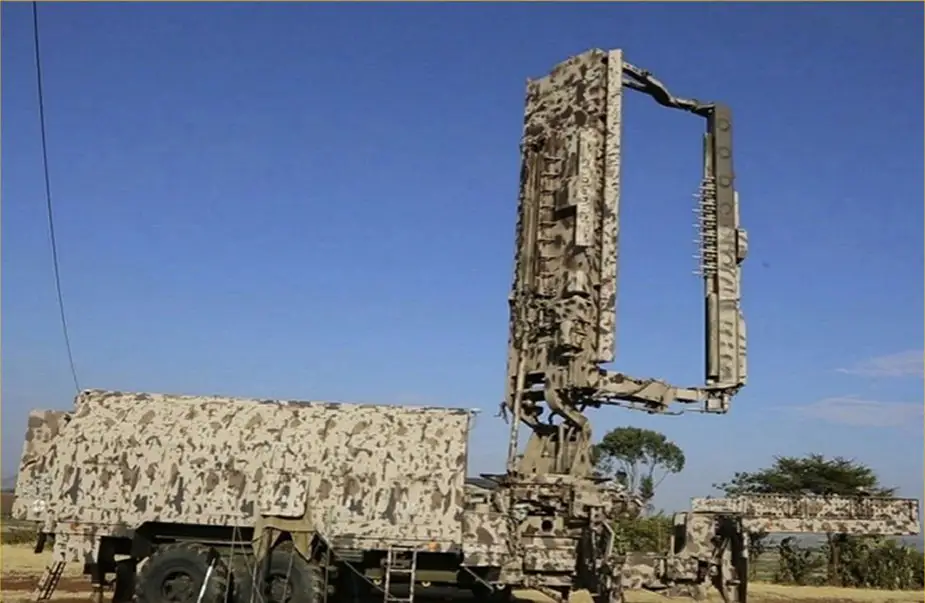Breaking news
New pictures released of Ethiopia's Pantsir-S2 and ST-68UM radar systems.
On August 28, 2023, new images surfaced on Russian social media platforms about the air defense systems employed by the Ethiopian Armed Forces. These images provide insights into the presence of air defense systems such as the Russian Pantsir-S2 and the Ukrainian ST-68UM radar station within Ethiopia's military setup. The Ethiopian military utilizes a range of air defense systems, which are strategically deployed to protect key assets like the controversial Hidase hydroelectric dam.
Follow Army Recognition on Google News at this link

New images expose Ethiopia's Russian Pantsir-S2 and Ukrainian ST-68UM radar (Picture source Russian social media)
The Grand Ethiopian Renaissance Dam (GERD), also known as the Hidase Dam, is a significant hydroelectric project situated on the Blue Nile River in Ethiopia. Initiated in 2011, the dam's main purpose is to generate electricity to meet Ethiopia's energy demands. With dimensions including a height of 145 meters and a length of 1,780 meters, along with a reservoir capacity of approximately 10.2 million cubic meters, the operational capacity is currently 750 MW, with future plans to increase it to 5.15 GW.
The construction of GERD has raised concerns about downstream impacts on water resources, particularly for downstream countries like Egypt and Sudan. Negotiations have been ongoing between Ethiopia, Egypt, and Sudan to address these concerns and establish a framework for sustainable water management.
In response to perceived security threats, Ethiopia has taken measures to protect the dam's infrastructure. These measures include procuring air defense systems from countries like Russia and Israel. These systems have been strategically positioned to defend against potential attacks. Reports from January 2020 indicate that Ethiopia received shipments of Pantsir-S1 air defense missiles.
The GERD project has led to geopolitical tensions, as downstream nations express concerns about the dam's effects on water availability, flooding patterns, and environmental stability. Collaborative water management, strategic water release, and long-term considerations are crucial in addressing these concerns and working toward a resolution that considers the interests of all parties.

Ethiopian Armed Forces use the Russian Pantsir-S2 air defense system (Picture source: Russian social media)
The Pantsir-S2, known as the SA-22 Greyhound within NATO, is a Russian-made surface-to-air missile and anti-aircraft artillery system. Its primary function is to protect military installations, industrial sites, and ground forces, while also bolstering air defense capabilities.
An important feature of the Pantsir-S2 is its adaptability, designed to counter a wide range of threats including aircraft, helicopters, drones, precision munitions, and cruise missiles. This versatility makes it effective in various scenarios, from standard airborne threats to more advanced guided munitions.
The system's advanced automation aids operators and enhances response times. Equipped with a comprehensive radar system, it can detect and track both air and ground targets, ensuring comprehensive coverage and situational awareness. In terms of armament, the Pantsir-S2 features twelve 57E6 surface-to-air guided missiles and two 2A38M 30mm automatic cannon guns. These capabilities allow the system to engage targets at different distances and altitudes.
The radar and optical control system are central to the Pantsir-S2's capabilities, facilitating precise detection, tracking, and engagement of both aerial and ground targets. The radar network includes a Target Acquisition Radar (TAR) in the E-band and a Target Tracking Radar (TTR) in the J-band, enabling initial detection and continuous tracking.
In terms of engagement capabilities, the Pantsir-S2 is designed to intercept targets at distances ranging from 1.2 to 20 kilometers and altitudes from ground level to 15 kilometers, using its missile arsenal. For closer threats, the twin 30mm cannons engage targets up to 4 kilometers away and altitudes of up to 3 kilometers.

Ethiopian Armed Forces also use the Ukrainian ST-68UM radar station (Picture source: Russian social media)
The Ukrainian ST-68UM (5N59) radar station is designed as a three-coordinate radar system with the specific purpose of detecting, identifying, and tracking airborne targets, including strategic cruise missiles such as the ALCM (Air-Launched Cruise Missile). This radar system remains effective even when faced with organized active and passive interference, as well as challenges like ground reflections and meteorological conditions. Its applications span various sectors, including the Air Defense Forces, communication units, radio technology departments, and the Air Force.
Operating within the centimeter wave range, the ST-68UM operates primarily in combat mode. It achieves elevation coverage through a partial radiation pattern and accomplishes azimuthal coverage through the mechanical rotation of its antenna system, rotating at either 6 or 12 revolutions per minute.
The radar system comprises two main components: radiotechnical equipment and an antenna system. Both are mounted on the chassis of a semi-trailer known as MAZ-938B. Additionally, a power supply system referred to as 99X6 is housed within a KP-10 van positioned on the chassis of an MAZ-5224B trailer. Depending on the desired configuration, the station can be equipped with a 40V6M tower and a 6IIOZ communication cabin. These additional components are integrated into the chassis of a KamAZ-4310 vehicle.
The inclusion of the tower serves to elevate the antenna's phase center to a height of 24 meters. This enhancement improves the radar's ability to detect targets flying at low altitudes, as well as its efficiency in wooded terrains. Conversely, the communication cabin is utilized for transmitting radar information and control commands over distances of up to 35 km.
The detection ranges of the ST-68UM radar system vary depending on different types of targets and altitudes. For aircraft like the MiG-21, the radar could reach a detection range of 147 kilometers (or 175 kilometers without the tower). For strategic ALCMs (Air-Launched Cruise Missiles), the detection range could reach 60 kilometers.























